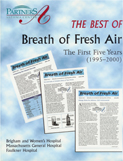Breath of Fresh Air: Feature Articles
Chapter 26: Ins and Out of Inhalers (Part II): Facts and Fictions
|
Many different types of medications for the treatment of asthma are delivered from inhaler devices. Some are bronchodilators that open the breathing passageways within a few minutes; they are used for quick relief. Others are preventative medications, meant to be used on a regular basis to control asthma every day and to prevent asthmatic attacks. Some of these preventative medications work for many hours at a time to relax the bronchial muscles that surround our airways (long-acting bronchodilators). Others work to quiet the allergic inflammation that is at the root of asthma (anti-inflammatory medications). Some of the common medications delivered by inhaler are listed in the accompanying table. The bronchodilator action from the quick relievers lasts about 4-6 hours. At one time persons with asthma were encouraged to use their quick relievers four times a day to keep the bronchial tubes open throughout the day. In careful experiments conducted at the Partners Asthma Center and elsewhere, it was found that regular use of the quick-relief bronchodilators was not necessary. It did not improve well-being or prevent asthmatic attacks. It is now recommended that these quick-relief bronchodilators be used only when needed to alleviate asthma symptoms. If you are feeling well, there is no need to use them. |
Use your “quick reliever”
inhaler only when needed to relieve asthma symptoms. Use your “controller/preventer” inhaler every day to prevent symptoms and protect against asthma attacks. The inhalers are not “addictive” and do not lose their effectiveness is used every day. |
|
|
On the other hand, the controller/preventer medications are meant to be taken every day. Even when you are feeling well, having asthma means that you are still vulnerable to triggers that can provoke asthmatic symptoms. The controller/preventer medications decrease the sensitivity of the bronchial tubes to these triggers and protect you against asthmatic attacks. Many persons with asthma were once advised to use first their quick-relief bronchodilators to open the bronchial tubes, followed by their controller/preventer medications, which could then penetrate deeper into the lungs. This sequence turns out to be unnecessary. The quick-relief bronchodilators can remain in your pocket or purse until needed for quick relief; they do not need to be taken in conjunction with your other inhalers. There is one circumstance in which the quick-relief bronchodilators can work well preventatively: use them prior to exercise or exerting yourself in cold air. If taken 10-15 minutes before the exercise or cold air exposure, these bronchodilators can prevent asthma symptoms that might otherwise be anticipated. |
Deaths from asthma are caused by the
inability to breathe, rarely by irregular heart
rhythms. |
|
|
You may have heard that using your inhalers regularly can be "addictive." Not true. If there were a cure for asthma developed tomorrow, you could stop using these medications without a moment of "withdrawal." You may have heard that if you use your medications every day, they will lose their effectiveness "when you really need them." Not true. Scientific studies have shown that they continue to be just as effective after months and years of use as they were when you first took them. Another fiction: you may have heard (or even read in the package inserts that come with inhalers) that you need to wait one minute between inhalations. In fact, the inhalers are ready to be actuated again within seconds of firing. After you have drawn the puff of medication into your lungs with a slow, deep breath and then held your breath for about 5 seconds, it is ready to deliver medication again. If your doctor recommends two or four puffs of medication from an inhaler, that means that you need to draw in each puff with a separate breath. It does not work well at all to spray two puffs into your mouth and then breathe both in at once. In the same way, if you use a spacer chamber with your inhaler, take one breath in for each spray delivered into the chamber. Do not "load up" the chamber with multiple doses; much of the medicine will be left behind in the chamber if you do. |
For each medication “puff,” take a separate breath in, even when using a spacer. |
Quick Relievers |
Regular Preventers / Controllers |
|
|
Anti-inflammatories:Steroids:
Non-steroidal:
|
Long-Acting Bronchodilators:
Combination Steroid with Long-Acting Bronchodilator:
|

